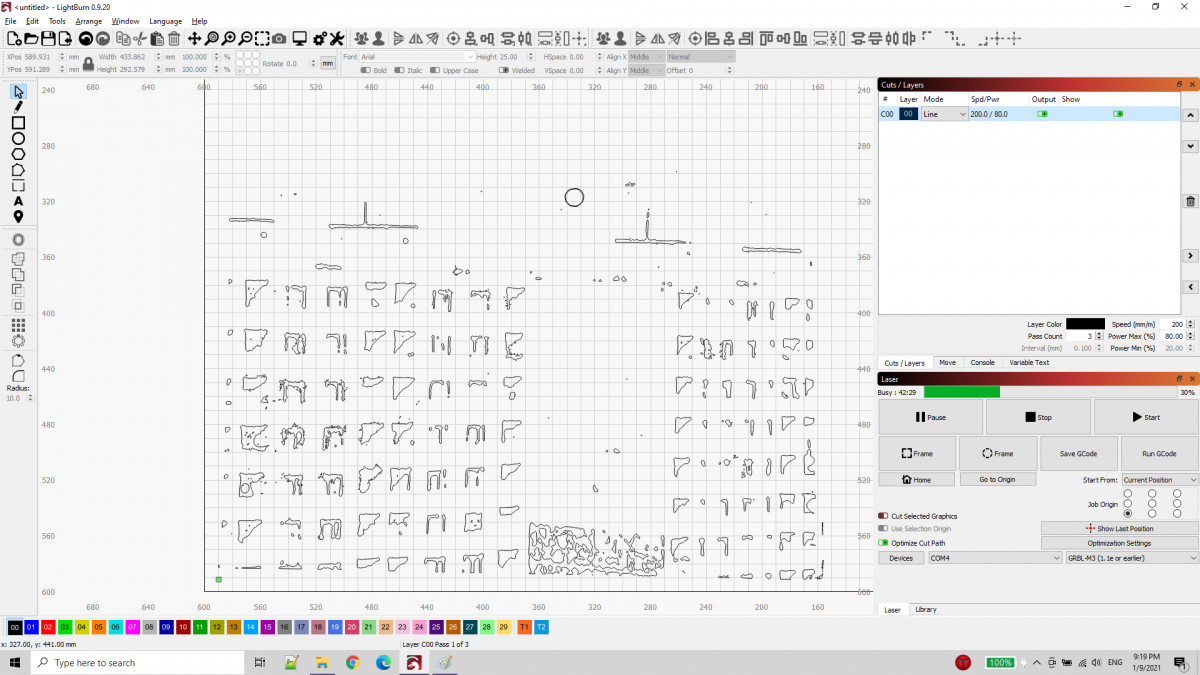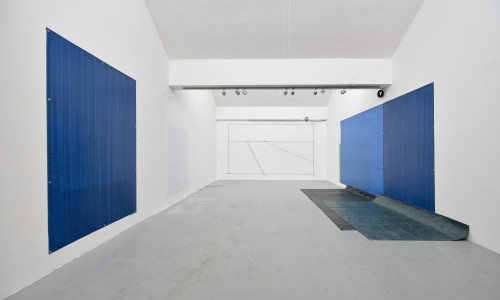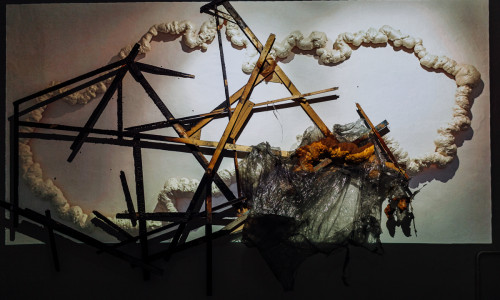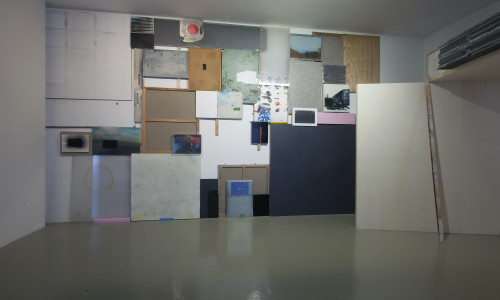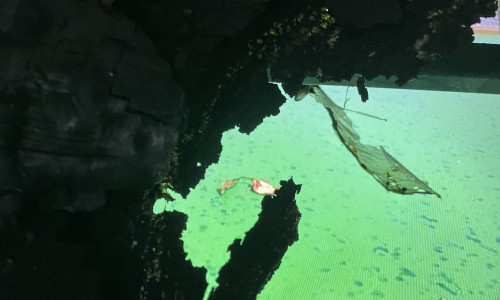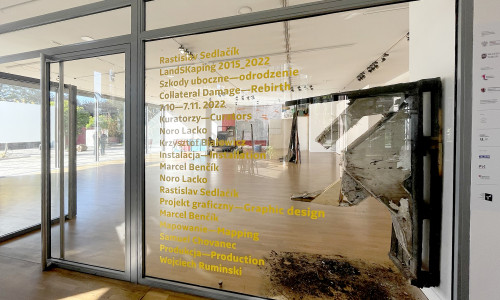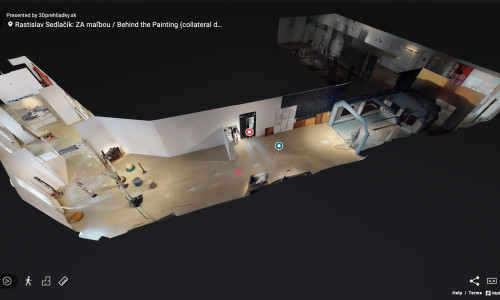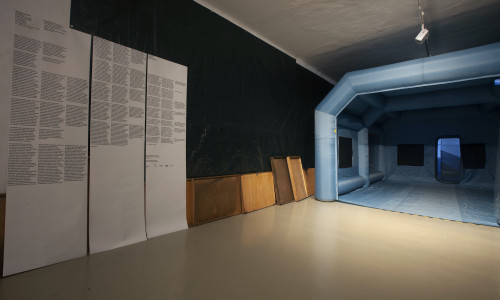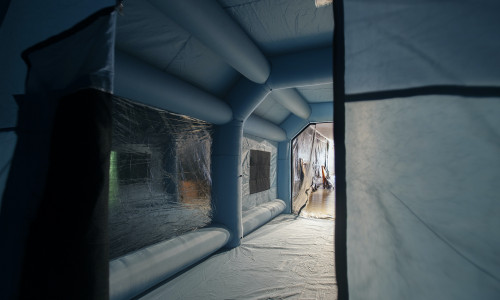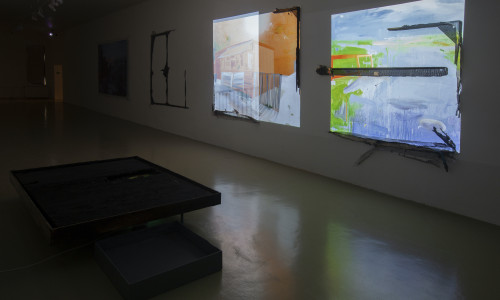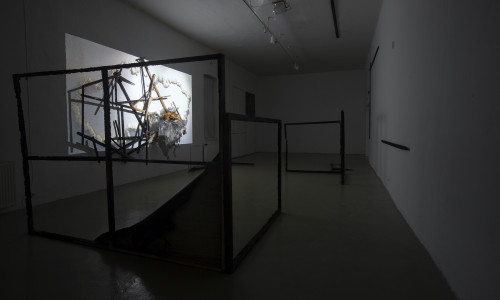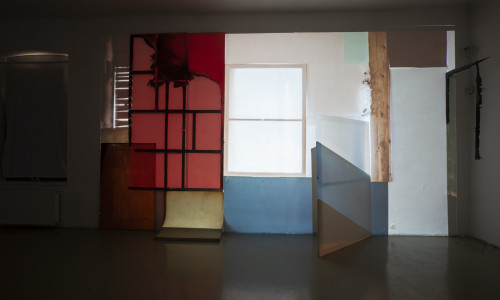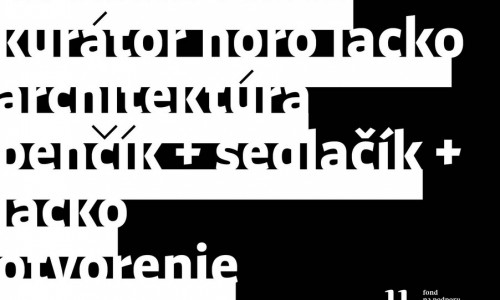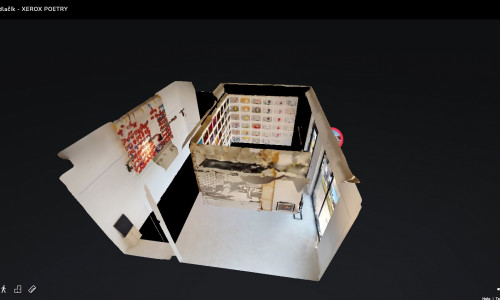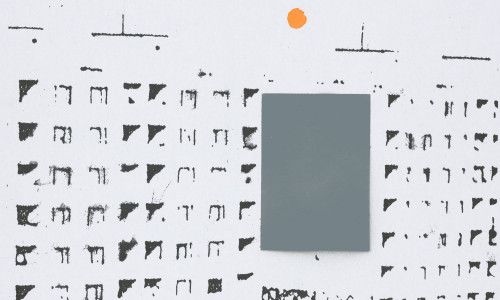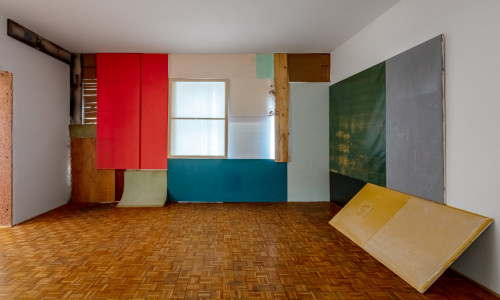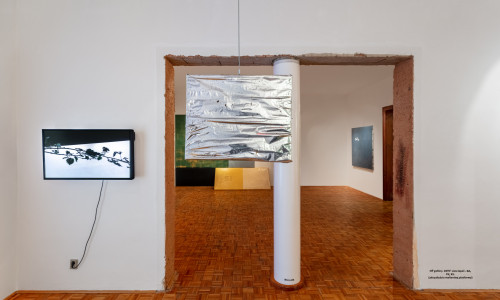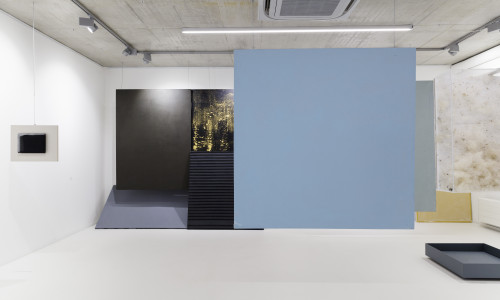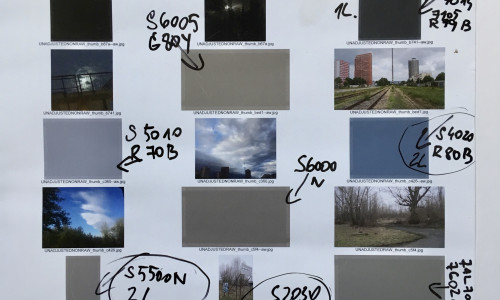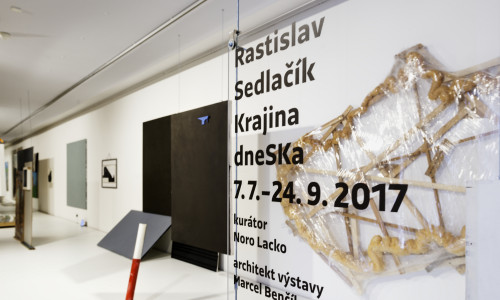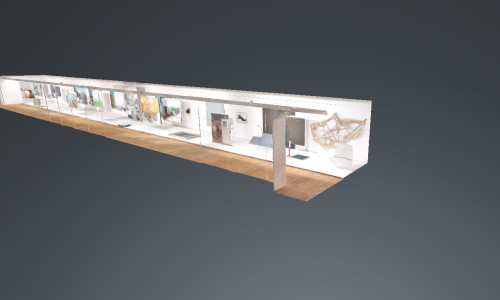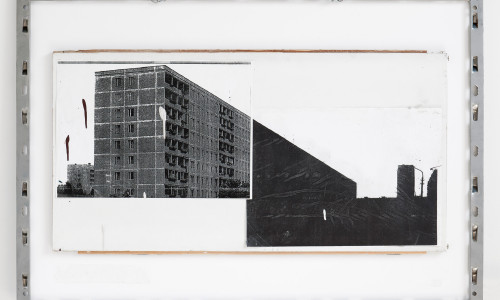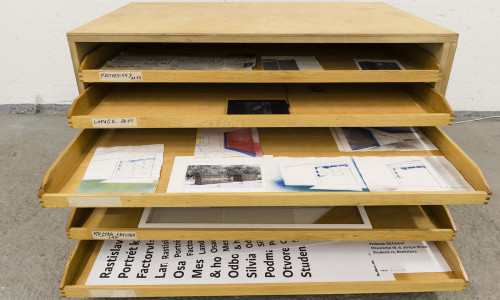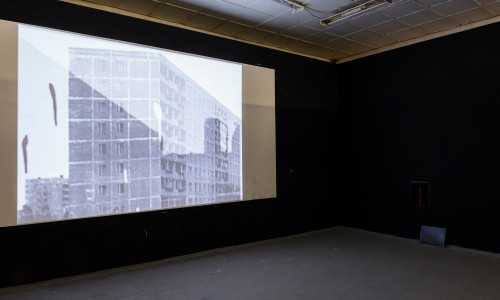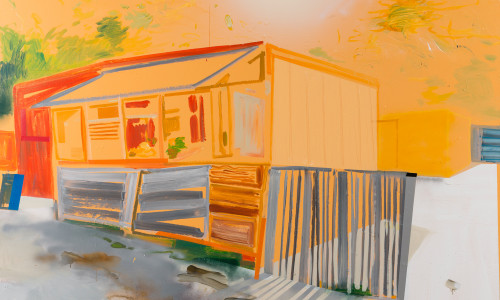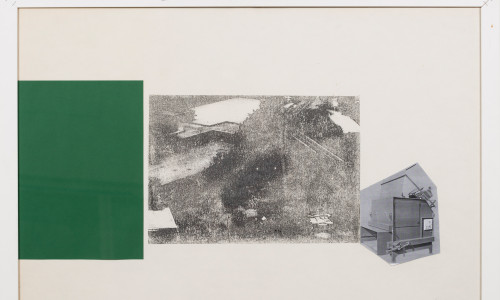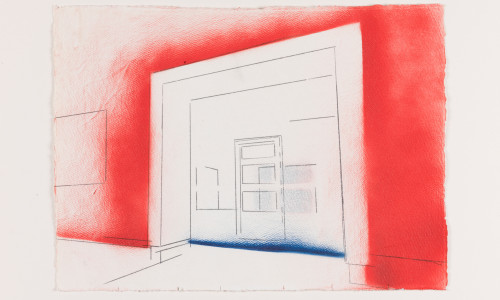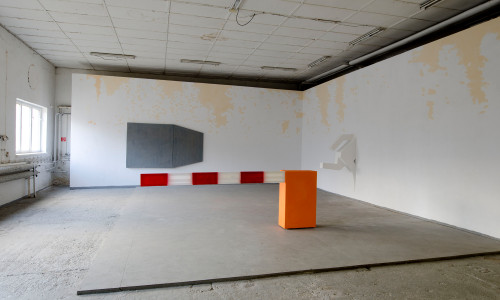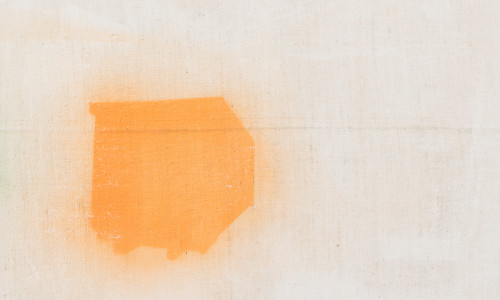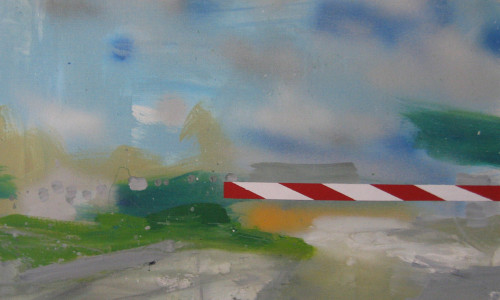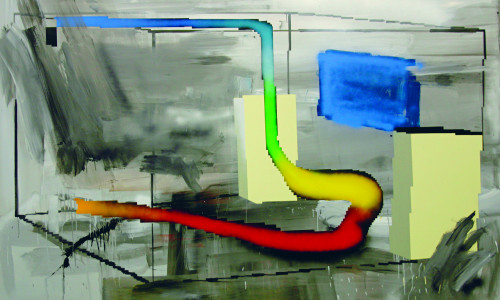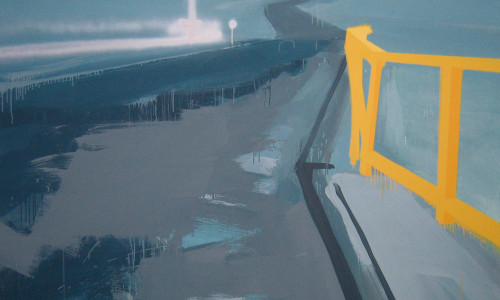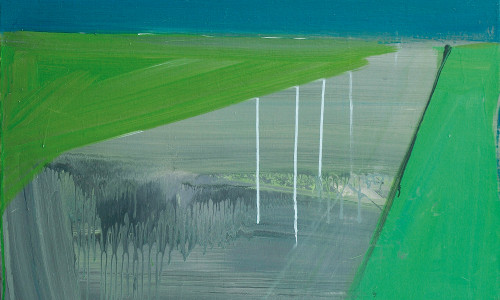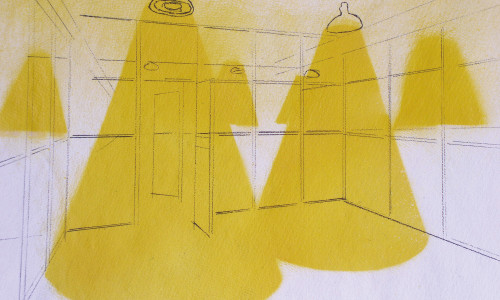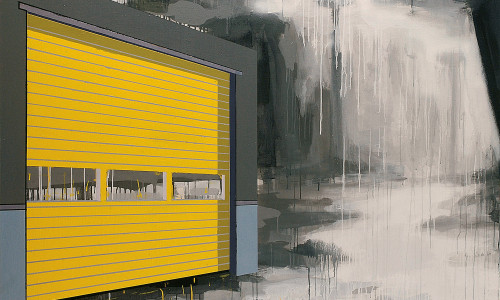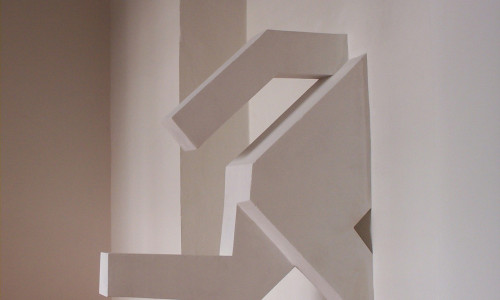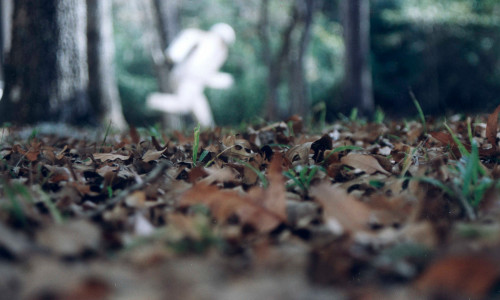Xerox poetry
Rastislav Sedlacik
Station Contemporary Art Gallery, Bratislava-Petržalka
foto Martin Deko
2021
Rastislav Sedlačík: Xerox poetry
Station Contemporary Art Gallery, Ul. Gustáva Mallého 2, Bratislava-Petržalka
Exhibition dates: 3. 9. 2021 – 3. 10. 2021
Exhibition opening 2. 9. 2021 at 18:00
Curator: Norbert Lacko
The starting point and, in addition to all the changes, a stable element of Rastislav Sedlačík's artwork lies in the program verification and commenting of the possibility of our visual experience with the landscape, but especially in the possibility of artistic manipulation of the image of our visual experience of the landscape. In the ongoing, at least somewhat orderly, and balanced retrospective of his more than twenty years of publicly exhibited art, we could tentatively identify at least two related thematic gravity centres in the vicinity of which the artworks oscillate, unwind, but also mutually explode and implode.
The first centre of gravity is the mutual contact of the urban and natural landscape. Landscape constructions of Sedlačík's terrain records and landscaping (in the expanding sense of the word from paintings, drawings, graphics, and their hybrids, through objects to chamber and most recently also generous formats and transformations of gallery site specific installations) are events of urban peripheries, places of adhesion and mutual entanglement civil-urban and natural margins. Although they are seen from a human perspective, they evoke the feeling of something that has escaped a person that is not for him or no longer needs him. The image of the landscape identified by Sedláčik is one of good-natured fascination, which puts prefabricated products of engineering, planning, and bricolages of domestic masters with the spontaneity of organic chaos into the same neighbourhood. The image of this experience is composed from the perspective of the human, sensorimotor body scheme, which is present in the city, but only temporarily – in transit. Instead of our presence in the country, it is rather the country present in our field of vision, seen from behind, above or across the city limits. The key is the perspective of a city pedestrian who is attracted to the periphery and who discovers the periphery even when we are prone to overlook it. The principle of image construction and its logic is quite simple: the urban element of civilization – a fragment of architecture – collides with the natural landscape. Abstracted geometric lines and regular rhythmic areas are confronted with abstracted spontaneous amorphous natural elements. A plan, a rule, or an order meets a coincidence. The container cuts the horizon line, the hangar door frames the view of the suburban steppe – this is Sedlačík's image of the landscape.
The same logic governs the selection of Sedlačík's artwork steps and techniques of this visual experience. Precise architectural elements sprayed or engineered throughout the template are adjacent to the manipulated randomness of organic brush strokes and the chaos of colour splatters.
The second centre of gravity is the (mostly) anonymous urban block of flats. The microworld of the natural, e.g. in the form of residual settlement vegetation, recedes into the background, becoming a peripheral, though still important, accent of the composition. Conversely, the macroworld of the natural, e.g. in the form of slightly dramatized natural cosmic events such as sunrises and sunsets, reduced to the coloured area of the basic geometric shape, become an important reminder that even this "bumfuck nowhere" still belongs to the larger universe. The plan of the painting is dominated by the grid or a square network formed by the walls and pores of prefabricated houses, fullness and emptiness, masses and their absence. Here, too, the perspective is organized quite civilly, through the view of a pedestrian, or from the window of a peeking spectator. However, the visual collision of geometry and spontaneous gesture is doubled by a paradox that Sedlačík aptly calls "random order". It is (on a case-by-case basis, but basically almost always at once) a random order, a chance disrupting order, as well as a system that occasionally (and therefore randomly) produces coincidences or even the systematic generation of coincidence. An illumination foreshadowing of this stable Sedlačík's paralogic could be the composition of the facade with variable constellations of luminous and dark windows of the night settlement. The corpus of these works of art also includes the latest ensemble of the same name presented at the Xerox poetry exhibition.
In recent years, the emphasis of Sedlačík's work has shifted significantly from plein air, memory or structurally imagined landscape recording to complex polyphonic dialogue of various processes creating a possible image of our landscape visual experience - from landscape image recording to process recording and process manipulation. This dialogue includes such variables as the visual art tradition of landscape painting, popular shared notions of landscape painting, spontaneity-driven ingenuity of untrained domestic DIYers, voracious developmental amusement, but also a significant daily oscillation of accidental and legitimate natural and social processes emitting growth and degradation, beginning and ending.
The preferred medium of Rastislav Sedlačík's artwork is, or originally was, painting. However, the expansion of painting into other media is also becoming more and more significant. At first, they were intentional, artificially created objects and object supplements of the hanging image as ironic, exaggerated and grotesque-monstrous imitations of fragments of urban landscape and industrial architecture. Later, post-products appeared in his repertoire, i.e. assemblages and collages of secondary, recycled, and found visual and object materials, but especially materials created as studio waste during other Rastislav's artistic activities – created from an excess of creative playful energy and a bit friendly childish innocent hooliganism, which belongs to Sedlačík's work and which suits it. Lately, he adds three or four - if we would give the Xerox poetry set a relatively autonomous status - new program elements of completely different orders.
The first is the Catchers series as works of almost uncontrolled chance, the main co-author of which is the city's environment. This fascination with the literal imprint already has its own history in Sedlačík's work. If his painting could be metaphorically understood as an imprint of a possible visual experience of the country - then this new fascination moves the metaphor into a technical approach from the fascination with unique mistakes in graphic printing to manipulated and completed xerocopies. From xerocopy to a rather ironically literal understanding of "plein air" painting as what it "captures". Painting as The Catcher, paint as an adhesive fixing accidental dirt and pollen fall. It is no longer a painting of a possible view of the landscape, or a painting in the open air, a free landscape, but a painting with a landscape and a painting with the open air. It could also be important that the colour of the monochromatic coating of each single catcher is generated according to the recalculation of the average colour of the open-air environment in which the placement of this catcher was planned.
The second is a cycle of large-format drawings – still-lifes called Settlement Bonsai, whose main co-authors are anonymous urban DIYers - beauticians, masters of small urban architecture, post-industrial ikebana arrangers and virtuoso minimalist urban interventions with an excess of creative energy (which is well understood by Sedláčik) or, in an urgent need to make the movement through the urban landscape more pleasant for oneself and fellow citizens, creating compositions of ornamental plant life and various waste-second-hand objects, such as used tires.
The third is engineeringly planned, but accidentally calculating - architectural re-constructions and pre-constructions of gallery spaces and exhibition installations, whose main co-author is graphic designer and architect of Sedláčík's exhibitions Marcel Benčík, with working contributions in recent years with the stable cooperating curator Noro Lacko. Here, too, the logic of "random order" is the standard starting point for creating the composition of a gallery installation. The basis is a regularly austere geometric square grid. A master plan, which faces a double dialogue. On the one hand, it is attacked by a set of exhibited works and their own voices, on the other hand, its application is modelled and transformed by the conditions of a particular gallery space and its specifics. There is certainly another question to be asked in a soft voice and remains to be answered: what is the relationship between the architectural, the space-creating and the organizing and / or disorganizing movement and visual, organizing view in these gallery installations, but also in the whole of Sedlačík's artwork?
The fourth and so far, most recent collection of Sedlačík's works of art is the corpus of the open painting-graphic-drawing post-product fusion Xerox poetry. Currently, it is a total of 365 (plus) pictorial graphic sheets, forming a quasi-daily record of the quarantine covid year 2020/2021. It was created at the intersection of Sedlačík's fascinations with the theme of the settlement landscape, the possibilities of manipulating the game with multiplications of unique errors in graphic printing and the xerocopy production process, as well as subsequent coloristic author's painting and drawing interventions. Here, too, is a reference to the "random order" paradox. On the one hand, it is an order directing compositional image solutions, based on a square network based on the layout of windows on the facade of the block of flats, often supported using graph paper. Artistically there is a multi-recycled air brush template previously used by Sedlačík during the creation of the settlement painting cycle BA, encountering gestural coloristic or drawing intervention. At the same time, it is the fixed algorithm itself and its subsequent variations, which are a generator of random and unique outputs.
Postproduct realisations bring around new opportunities. Gradually, with the increasing realizations, Sedlačík relaxes and more and more indulges in a game of chance that thwarts the plan: the moment of the idea, the secondary use of studio waste and the moment of wit, as extending the line of escape before the rule or ban. He enjoys inventing (impossible) authoring techniquesbut in contrast to this uncontrollable and dusty swirling coincidence, Sedlačík's latest exhibitions are the work of laborious planning of the design and installation transformation of a set of works of art and a disparate gallery space into one comprehensive visual-spatial work.
Noro Lacko
Rastislav Sedlačík: Xerox poetry
Station Contemporary Art Gallery, Ul. Gustáva Mallého 2, Bratislava-Petržalka
Trvanie výstavy: 3. 9. 2021 – 3. 10. 2021
Otvorenie výstavy: 2. 9. 2021 o 18.00 hod.
Kurátor: Norbert Lacko
Východisko a popri všetkých premenách aj stabilný prvok výtvarnej práce Rastislava Sedlačíka spočíva v programovom overovaní a komentovaní možnosti našej vizuálnej skúsenosti s krajinou, no najmä možnosti výtvarnej manipulácie s možným obrazom našej vizuálnej skúsenosti krajiny. V priebežnom, aspoň trochu upratujúcom a bilancujúcom zretrospektívňovaní jeho doterajšej, už vyše dvadsaťročnej, verejne vystavovanej výtvarnej tvorby by sme mohli v opatrnom pracovnom provizóriu identifikovať minimálne dve príbuzné námetovo-tematické gravitačné centrá, v blízkosti ktorých oscilujú, odvíjajú sa, ale aj vzájomne preplietajú, explodujú a opätovne implodujú jeho výtvarné práce.
Tým prvým centrom gravitácie je vzájomný kontakt urbánnej a prírodnej krajiny. Krajinné konštrukty Sedlačíkových terénnych záznamov a terénnych úprav (v expandujúcom zmysle slova od malieb, kresieb, grafík a ich hybridov, cez objekty až po komorné a najnovšie aj veľkorysé formáty a transformáty galerijných site specific inštalácií) sú udalosťami mestských periférií, miest priľnutia a vzájomného zakliesnenia okrajov civilizačne-urbánneho a prírodného. Sú síce videné z pozície človeka, ale vzbudzujú pocit niečoho, čo človeku ušlo, čo pre neho nie je, alebo ho už nepotrebuje. Sedlačíkom identifikovaný obraz krajiny je obrazom dobromyseľnej vizuálnej fascinácie stavajúcej do vzájomného susedstva prefabrikátové produkty inžinierskeho plánovania, brikoláže drobných domácich majstrov a živelnú spontaneitu organického chaosu novej divočiny vznikajúcej v medzerách a na okrajoch mestskej zástavby. Pohľad je organizovaný z perspektívy ľudskej, senzomotorickej telesnej schémy, ktorá je prítomná v meste, ale len akosi prechodne, tranzitne. Namiesto našej prítomnosti v krajine je to krajina prítomná v našom zornom poli. Kľúčová je tu perspektíva mestského chodca, ktorý je priťahovaný perifériou a ktorý objavuje perifériu aj tam, kde sme ju skôr náchylní prehliadať. Logika výstavby kompozície je vcelku jednoduchá: mestský civilizačný prvok, fragment architektúry, koliduje s prírodným krajinným prostredím. Abstrahované geometrické línie a pravidelné rytmizované plochy sú konfrontované s abstrahovanou spontánnou amorfnou živelnosťou organického. Plán, pravidlo alebo príkaz sa stretáva s náhodou. Kontajner rozčesol líniu horizontu, dvere hangára rámujú výhľad na prímestskú divočiacu step – to je sedlačíkovský obraz krajiny.
Rovnaká logika riadi aj výber postupov a techník Sedlačíkovej výtvarnej práce. Precízne cez šablónu nastriekané alebo inžiniersky výkresovo vykresľované architektonické prvky susedia s manipulovanou náhodnosťou organických ťahov štetca a s chaosom stekancov farieb.
Tým druhým centrom gravitácie sú (zväčša) anonymné mestské panelákové sídliskové prostredia. Mikrosvet prírodného, napr. v podobe reziduálnej sídliskovej vegetácie, tu ustupuje do úzadia, stáva sa periférnym, aj keď ešte vždy dôležitým akcentom kompozície. A naopak makrosvet prírodného, napr. v podobe mierne dramatizovane odprírodnených kozmických udalostí ako sú východy a západy slnka, redukované na kolorovanú plochu základného geometrického útvaru, sa stáva dôležitou pripomienkou, že aj táto „prdel sveta“ ešte vždy patrí k univerzu. Plánom obrazu dominuje raster či mustra štvorcovej siete tvorenej stenami a pórmi panelových domov, plnosťou a prázdnom, hmotami a ich absenciou. Aj tu je pohľadová perspektíva organizovaná celkom civilne, situáciou chodca, prípadne z okna vykúkajúceho diváka. Vizuálna kolízia geometrie a spontánneho gesta je však zdvojená o paradox, ktorý Sedlačík pomenúva nenašsky, ale výstižne „random order“. Ide (od prípadu k prípadu, ale v podstate takmer vždy naraz) o náhodne vzniknutý poriadok, náhodu narúšajúcu poriadok, ako aj o systém občasne (a teda náhodne) produkujúci náhody či dokonca o systematické generovanie náhody. Iluminačným predobrazom tejto stabilnej Sedlačíkovej paralogiky by mohla byť kompozícia fasády s premenlivými konšteláciami svietiacich a temných okien nočného sídliska. Do korpusu týchto výtvarných prác patrí aj aktuálne najnovší rovnomenný súbor prezentovaný na výstave Xerox poetry.
Dôraz Sedlačíkovej práce sa v posledných rokoch výrazne presúva od plenérového alebo pamäťového či konštrukčne imaginovaného záznamu krajiny k zložitému polyfonickému dialógu rozličných procesov vytvárajúcich možný obraz našej vizuálnej skúsenosti krajiny – teda od záznamu obrazu krajiny k záznamu procesu a manipulácii s procesom, ktorým obraz krajiny vzniká. Do tohto dialógu vstupujú také veličiny vizuálneho prostredia ako výtvarne umelecká tradícia krajinomaľby, populárne zdieľané predstavy o obraze krajiny, spontaneitou riadená vynaliezavosť neškolených domácich šikovníkov, žravá developerská amúzickosť, ale aj nezanedbateľná každodenná oscilácia náhodných a zákonitých prírodných či sociálnych procesov emitujúca rast a degradáciu, vznikanie a zanikanie.
Preferovaným médiom výtvarnej práce Rastislava Sedlačíka je, respektíve pôvodne bola maľba, no čoraz výraznejšími a dôležitejšími sa stávajú aj expanzie maľby do iných médií. Najsamprv to boli intencionálne, umelo vytvárané objekty a objektové suplementy závesného obrazu ako ironické, zveličujúce a groteskno-obludné nápodoby fragmentov mestskej krajiny a industriálnej architektúry. Neskôr sa v jeho repertoári objavili postprodukty, čiže asambláže a koláže druhotne, recyklačne spracovaných, nájdených vizuálnych a objektových materiálov, no najmä materiálov vzniknutých ako ateliérový odpad pri iných Rasťových výtvarných aktivitách, vytvárané z nadbytku tvorivej hravej energie a tak trochu aj z prívetivého detsky nevinného chuligánstva, ktoré k Sedlačíkovej tvorbe patrí a ktoré jej pristane. Najnovšie k nim pridáva tri či štyri – ak by sme súboru Xerox poetry dopriali relatívne autonomizovaný status – nové programové prvky úplne odlišných rádov.
Prvým je aktuálne otvorená séria lapačov ako diel takmer neriadenej náhody, ktorých zásadným spoluautorom je environment mesta. Nová podoba fascinácie doslovnosťou odtlačku má u Sedlačíka tiež svoju vlastnú vývinovú trajektóriu. Ak jeho maľba mohla byť metaforicky chápaná ako odtlačok možnej vizuálnej skúsenosti krajiny, tak nová fascinácia posúva túto metaforu do pozície technického prístupu: od hry s jedinečnými chybami v grafickej tlači, cez manipulovanú a dotváranú xerokópiu fotografických odtlačkov sídliskovej zástavby k celkom nezmyselnému, na hranicu možného posunutému a ironicky doslovnému chápaniu „plenérovej“ maľby ako toho, čo „zachytáva“. Maľba ako lapač, náter ako lepidlo fixujúce náhodné nečistoty a spad peľu. Už nie maľba možného pohľadu na krajinu či maľba v plenéri, voľnej krajine, ale maľba krajinou a maľba plenérom. Dôležitým, by mohlo byť aj to, že farebnosť samotného monochromatického náteru každého jedného lapača je vygenerovaná podľa prepočtu priemernej farebnosti plenérového prostredia, do ktorého bolo umiestnenie tejto pasce plánované.
Druhým je cyklus veľkoformátových kresieb – zátiší s názvom Sídliskové bonsaje, ktorých zásadnými spoluautormi sú anonymní mestskí kutilovia-skrášľovači, majstri drobnej mestskej architektúry, aranžéri postindustriálnych ikebán a virtuózi minimalistických urbanistických zásahov z prebytku tvorivej energie (ktorej Sedlačík veľmi dobre rozumie), a/alebo v nástojčivej potrebe spríjemniť sebe a spoluobyvateľom pohyb mestskou krajinou vytvárajúci kompozície okrasnej kveteny a rozličných odpadových, druhotne použitých objektov, napríklad ojazdených pneumatík.
Tretím sú inžiniersky plánované, ale s náhodou kalkulujúce architektonické re-konštrukcie a pre-konštrukcie galerijných priestorov a výstavných inštalácií, ktorých zásadným spoluautorom je grafický dizajnér a architekt Sedlačíkových výstav Marcel Benčík, s pracovným prispením v posledných rokoch už s dvojicou Sedlačík – Benčík stabilne spolupracujúceho kurátora Nora Lacka. Aj tu je paralogika „random order“ štandardným východiskom tvorby kompozície galerijnej inštalácie. Základom je pravidelne strohý geometrický štvorcový raster. Mustra, ktorá vstupuje do dvojitého dialógu. Na jednej strane je atakovaná súborom vystavovaných prác a ich vlastnými hlasmi, na strane druhej jej uplatnenie modelujú a transformujú danosti konkrétneho galerijného priestoru a jeho špecifiká. Určite je tu ešte jedna zatiaľ len polohlasom položená otázka, na ktorú bude treba hľadať odpoveď: aký je vlastne v rámci týchto galerijných inštalácií, ale aj v rámci celku Sedlačíkovho výtvarného diela vzájomný vzťah medzi architektonickým, tvoriacim priestor a organizujúcim a/alebo dezorganizujúcim pohyb, a vizuálnym, organizujúcim pohľad?
Štvrtým a nateraz najnovším súborom Sedlačíkových výtvarných prác je korpus otvorenej maliarsko-graficko-kresliarskej postproduktovej fúzie Xerox poetry. Ide v tejto chvíli o celok 365 (plus) obrazov-voľných grafických listov, tvoriacich kvázidenníkový záznam karanténneho covidového roku 2020/2021. Vznikal na priesečníku sedlačíkovských fascinácií témou sídliskovej krajiny, možnosťami manipulantovej hry s multiplikáciami jedinečných chýb v grafickej tlači a pri procese výroby xerokópie, ako i následnými koloristickými autorskými maliarskymi a kresliarskymi zásahmi. Aj tu je odkaz k paradoxu „random order“ namieste. Na jednej strane je to ordinácia usmerňujúca kompozičné riešenia obrazu, ktorej základom sa stáva štvorcová sieť vychádzajúca z rozloženia okien na fasáde paneláku, často podporená aj zdvojením prostredníctvom použitia média milimetrového papiera – výtvarne je tu mnohonásobne recyklovaná air brushová šablóna, ktorú Sedlačík využíval napr. pri tvorbe sídliskového maliarskeho cyklu BA, stretávajúca sa s gestickým koloristickým alebo kresliarskym zásahom. No zároveň je to samotný pevne stanovený algoritmus a jeho následné variácie, ktoré sú generátorom náhodných a jedinečných výstupov.
Postproduktové realizácie prinášajú novú možnosť. Sedlačík sa uvoľňuje a čoraz viac oddáva hre s náhodou, ktorá prekazí, alebo nahradí plán: okamihom nápadu, druhotným využívaním ateliérového odpadu a momentom vtipu ako predlžením línie úniku pred pravidlom či zákazom. Baví sa a uhýba disciplíne maľby vymýšľaním (ne)možných autorských techník, no v kontraste s touto nekontrolovateľnou a prašne víriacou náhodnosťou sú posledné Sedlačíkove výstavy dielom prácneho plánovania konštruktérsko-inštalačnej transformácie súboru výtvarných prác a nesúrodého galerijného priestoru na jedno ucelené vizuálno-priestorové dielo.
